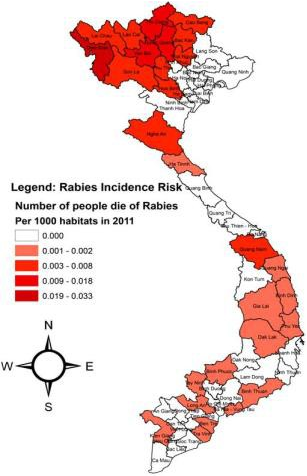The Government of Viet Nam issues the “National Program for Rabies Control and Elimination, 2017-2021”

Rabies is considered to be a widespread, neglected and under-reported zoonosis with an almost 100% case fatality rate in animals and humans. The disease causes a significant social and economic burden in many countries worldwide.[1] According to the study "Estimating the economic impact of canine rabies in Viet Nam [2]” over the period from 2005 to 2014, 914 deaths due to rabies were recorded, meaning there was an average of 91.4 deaths per year. The total economic impact of canine rabies to Viet Nam from 2005 to 2014 was over 14.8 trillion VND. Rabies is also recognized as a high priority disease among the prioritized zoonotic diseases to be addressed through collaboration between the human health and animal health sectors (Circular 16/2013-TTLT-BYT-BNN&PTNT dated 27 May 2013). Therefore, a One Health approach is recommended to be applied in responding to this disease. The ASEAN Rabies Elimination Strategy (ARES) provides a strategic framework for the reduction and eradication of rabies in member countries through the adoption of a One Health approach. The ARES was endorsed by both the 12th ASEAN Health Ministerial Meeting (AHMM) and the 36th ASEAN Agriculture and Forestry Ministerial Meeting (AMAF) in September 2014. Viet Nam is a lead country on rabies prevention in ASEAN.

In recent years, the Government of Viet Nam has made enormous efforts in Rabies prevention and control. The "National Program for Rabies Control and Elimination, 2017-2021", issued by the Prime Minister according to Decision No. 193/QĐ-TTg dated 13 February 2017, has the overall objective of managing Rabies in domestic dogs and humans in Viet Nam, with the aim of eliminating Rabies throughout the country. The Program is jointly managed by the Ministry of Agriculture and Rural Development (MARD) and the Ministry of Health (MOH), in collaboration with other agencies such as the Ministry of Education and Training (MOET), the Ministry of Information and Communications (MOIC), the Ministry of Finance (MOF) and the Ministry of Planning and Investment (MPI), as well as by People's Committees at the provincial level. The specific objectives of the Program include:
· Establishing a list of dog-raising households in over 95% of communes, wards and towns.
· Achieving a vaccination rate of domestic dogs in communes, wards and towns of over 85%.
· No cases of canine rabies being detected in over 70% of all provinces over two consecutive years.
· Reducing the number of provinces with a high incidence of rabies in humansby 60%.
· Reducing thenumber of deaths due to rabies by 60% in 2021 compared to the average number of cases during the period from 2011 to 2015.
Achieving the above-mentioned objectives requires specific tasks and solutions, including better management of domestic dogs, improving vaccination for dogs, post-exposure prophylaxis for humans, completing the national legal and policy framework, improving the capacity of surveillance, diagnostic and testing systems, and investigation and handling of outbreaks, etc. In addition to resources from central and local budgets, external resources will also be mobilized to support the prevention and control of rabies in Viet Nam.
The study “Estimating the economic impact of canine rabies in Viet Nam, 2005-2014”, commissioned within the scope of the project “Strengthening Capacity for the Implementation of One Health in Viet Nam (SCOH)” funded by USAID through UNDP, made several noteworthy recommendations. According to this study, in order to achieve the objective of eliminating rabies, Viet Nam must increase expenditures on dog vaccination efforts while maintaining or increasing PEP coverage. Under Phase 2 of the SCOH project, the OHP Secretariat will continue to support the GoVN on monitoring the implementation of the ARES Action Plan in Viet Nam and implementation of regional activities to which Viet Nam has committed in order to fulfil the country’s role as a lead country for this Strategy./.
[1] http://vncdc.gov.vn/files/article_attachment/2015/3/endorsed-ares-final.pdf
[2] The report “Estimating the economic impact of rabies in Viet Nam, 2005-2014” (Shwiff, S.A., Elser, J. & Hoang, T.X. (2016)) was commissioned for the OHP through the USAID-funded project “Strengthening Capacity for the implementation of One Health in Viet Nam”.


